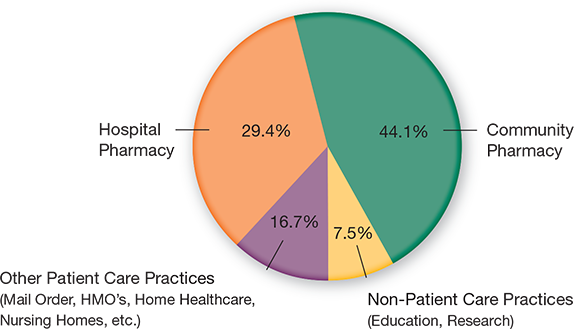1.4 Contemporary Pharmacy Settings
As already described, there are both community pharmacies and institutional pharmacies. An overview of some of the common settings within these categories can provide you with a sense of the career scope for where technicians work.
Community Pharmacies
Community pharmacies, which are also called retail pharmacies, are the “drug stores” that include not only pharmaceuticals but supplements, durable medical equipment (such as crutches, splints, slings, syringes), cosmetics, stationery, gifts, and other miscellaneous purchases.
 IN THE REAL WORLD
IN THE REAL WORLD
In the 1980s, the Goodrich Pharmacies in Central Minnesota established an agreement with local physicians to offer drug substitution counseling. Since then, the practice of Goodrich pharmacists counseling patients has grown dramatically. Through collaborative practice agreements (CPAs), Goodrich offers expanded patient care services to area patients and employees of the University of Minnesota, among others. To provide expanded patient care services, Goodrich depends on educated pharmacy technicians. Goodrich hosts internships and externships for pharmacist and technician students from the local university and technical and community colleges.
Goodrich Pharmacy stores also offer simple health services to general customers, such as vaccines; chronic disease management and cessation of smoking classes; low-cost screenings for high cholesterol, high blood pressure, asthma, and diabetes; and health education classes. Their customer MTM services include an information-gathering consultation, creation of a personalized care plan with treatment and goals, and continuous follow-up on patient progress. They remind patients, “The most expensive medication is the one you take incorrectly.”
In community pharmacy settings, pharmacy technicians tend to have more direct patient contact than in other settings. Community pharmacies can also offer off-site pharmaceutical delivery services to assisted living and nursing homes, which provide institutional services predominantly to older adults or disabled residents who can no longer provide care for themselves at home. These facilities may also be tailored for those with debilitating diseases or conditions, such as Alzheimer’s disease, stroke, or amyotrophic lateral sclerosis. Community pharmacies generally come in five main kinds: independent, chain, institutional, HMOs, and mail-order.

Many metropolitan areas have one or more community pharmacies that provide pharmacy services 24 hours a day, seven days a week.
Independent Pharmacies
These drug stores are usually owned and operated by a pharmacist or group of pharmacists. The pharmacist–owner makes the decisions about the practice, the range of retail products offered, standards, and technician responsibilities. They also decide to what degree they want to offer expanded patient care services. Some independent pharmacies may decide to become “compounding only” pharmacies of products individualized or not readily available commercially.
Chain Pharmacies
These retail operations consist of four or more stores run by a regional or national corporation that makes the decisions about customer initiatives and employee standards. They have the stand-alone corner drug store model (e.g., Walgreens, CVS, Rite Aid) or are a division of a department store (e.g., Walmart, Target) or grocery store (e.g., Kroger, Publix). These stores are usually in metropolitan areas and have a great deal of automation. Some have established walk-in clinics staffed by prescribers (such as nurse practitioners) for basic health assessments, specialty clinics for HIV/AIDS, or educational services on chronic illnesses or the cessation of smoking.
Institutional Community Pharmacies
More and more healthcare organizations, such as hospitals, clinics, and universities, are opening their own community pharmacies since patients like to have a one-stop experience. Operation and employment decisions do not come from the specific pharmacists that work there, but from the healthcare organization that runs them.
Health Maintenance Organizations (HMO)
In pharmacies run by an HMO, there are no insurance claims to fill out. Patient-related costs are paid as part of the network with its established fees. Prescribers, nurses, and pharmacists all have direct access to electronic medical records for each patient. Communications on best care plans are shared with the healthcare team. There is a formulary of approved drugs to help control costs and inventory.
Mail-Order or Warehouse Production Pharmacies
These are highly automated and are often run by large retail chain pharmacies, HMOs (for refills), insurance companies, and the Veterans Administration (VA). Technicians have contact with patients over the phone and through online interactions. They check prescriptions for accuracy and completeness, and process them for pharmacy approval and mailing. The technicians utilize sophisticated automation in an assembly-line environment. This growing pharmacy production and warehousing approach often has better pay and benefits for some technician positions because of the high volume. The technicians may also process insurance claims (if the pharmacy is not run by an HMO) and handle stocking and inventory duties. Mail-order pharmacies often dispense medications in 90-day increments.
Institutional Pharmacies
Institutional pharmacies are pharmacies organized under a corporate structure that follow specific rules and regulations for accreditation. They service healthcare facilities, such as the following: hospitals, long-term care facilities, home healthcare pharmacies, and specialty compounding pharmacies.
Hospital Pharmacies
Approximately one-fourth of all technicians work in a hospital pharmacy to supply patients with their hospital-prescribed medications. Together, the pharmacists and technicians prepare 24- to 72-hour drug dosage supplies and oversee an extensive floor stock inventory. Many work in a completely sterile cleanroom setting to prepare IV solutions. HMOs may have their own hospitals and have institutional pharmacies within them. University hospitals may also have pharmacy research laboratories.
Long-Term Care Facilities
In assisted living facilities (ALF) and skilled nursing facilities (SNF), both medical and residential care are provided, offering round-the-clock care, often entailing sterile IV solutions. Facilities that treat mental health patients suffering from acute or chronic psychiatric disorders or patients with traumatic brain or spinal injuries requiring in-patient rehabilitation also sometimes have on-site pharmacies.
 Pharm Fact
Pharm Fact
Some early medicines had alcohol or “spirits” in them. Now some states have pharmacies that also sell alcohol.
Home Healthcare Pharmacy
The institutional delivery of medical, nursing, and pharmacy services and supplies to patients in their homes is home healthcare. Also part of this institutional pharmacy service are deliveries to home hospice care and palliative care—which are focused on supplying pain relief and quality of life for those who have terminal conditions (hospice) or serious, ongoing painful debilitating illnesses (palliative). Treating patients in their own homes is less costly than in a hospital, generally more pleasant, and less uprooting for the patient. The pharmacist and pharmacy technicians work to provide IV infusions and oral medications, and they often need to be available for emergencies at odd hours. The medications are prepared and then picked up by or delivered to the attending nurse, who then dispenses the medications, educates the patient or patient’s caregiver on use, and monitors the patient’s progress. If the home healthcare system does not have its own pharmacy, it often contracts with specialty compounding or community pharmacies for services.

Pharmacists and pharmacy technicians work with nurses to provide medications for nursing homes, hospice settings, and homebound patients.
Specialty Compounding Pharmacies
Sterile compounding pharmacies specialize in sterile compounds such as IV solutions, parenteral nutrition, and injections. Hazardous compounding pharmacies utilize toxic substances that are chemical, biological, or radioactive (nuclear pharmacies). There are more than 100 diagnostic and therapeutic uses for such compounds, including cancer treatments. These pharmacies are typically located off-site and managed by one of several specialty pharmaceutical manufacturers. Because of the unique equipment and inherent hazards, these pharmacies are staffed by pharmacists and technicians with advanced training.
Figure 1.1 Practice Settings for Today’s Pharmacist
Technicians work where pharmacists work. Trends suggest a gradual increase in chain and mail-order pharmacies at the expense of independent community pharmacies. Long-term care and home healthcare pharmacies are expected to increase along with the aging US population.

Source: 2014 National Pharmacist Workforce Study by the American Association of Colleges of Pharmacy